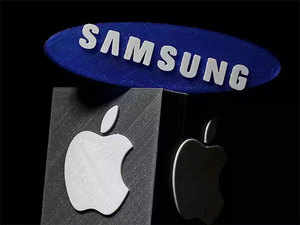

Goldman Sachs analyst Rod Hall and his team made a big call on February 20, favouring Samsung’s new folding phone, the Galaxy Fold. He told clients that Apple’s iPhone range might be two years behind the curve. A folding phone “may not be doable for Apple,” he said. “We see this as challenging for Apple who could find themselves with no access to the critical flexible OLED technology for which we believe Samsunghas at least a two year lead over other display competitors.”
This feels absurd. Is Apple really two years behind the future of phones? History shows that idea is plausible.
Samsung is known for its gimmicks. The Fold costs nearly $2,000 and launches into a marketplace where almost no one has ever said, “gee, I wish this was fold-ier.”
Predictably, pro-Apple bloggers like John Gruber dumped all over the Fold. “I look at the Galaxy Fold and I still see a prototype. It looks terrible when folded — a thick device with a tiny display with huge forehead and chin… It just seems clunky,” he wrote. A couple of days later he added: “The Galaxy Fold looks like a prototype, not a shipping product. I think flexible, foldable displays have a good future, but this isn’t it.”
IT’S 2010 ALL OVER AGAIN
But now, in Barcelona at the massive Mobile World Congress tech trade show, foldable phones are the only story. The concept is simple. It’s a phone roughly the size of an iPhone XS or XR, but it opens up like a book and then you’re looking at a screen twice the size on the inside (Samsung) or on the outside (Huawei Mate X). Suddenly, it feels like 2010 all over again. That year, Samsung began selling largescreen “phablets” — a move scorned by Apple at the time.
Former Apple CEO Steve Jobs said then, “You can’t get your hand around it” and “no one’s going to buy that.” By 2013, however, Apple realised Jobs was wrong. Internal documents produced for a lawsuit showed that iPhone sales growth was slowing, even though the market as a whole was growing fast. All the growth was among phones with screens bigger than 4 inches.
The iPhone was 3.5 inches. “Consumers want what we don’t have,” was the title of one slide in Apple’s documents.
It was not until 2014 that Apple managed to launch the iPhone 6, its first large-screen phone.
PEOPLE WANT LARGER SCREENS
Today, it’s obvious why people like larger screens. They want to see their photos at scale. They want to play games and have the full experience. They want to watch movies they can actually see.
Folding screens are a giant step up for anyone who wants that. (Just imagine reading a book that’s actually the size of a book.) And yet they are the same size as a regular phone. The threat to Apple is that Samsung and Huawei have correctly identified that people want big screens in their pockets, and they are already in production. At Apple, they exist only as patented diagrams, as far as we know.
It took Apple four years to catch up with Samsung when the latter began setting the pace in large screens.
Today, iPhone sales are in actual decline and there is no hint of a new iPhone format in sight. It will be interesting to see how long Apple waits this time around.
[“source=economictimes.indiatimes”]

